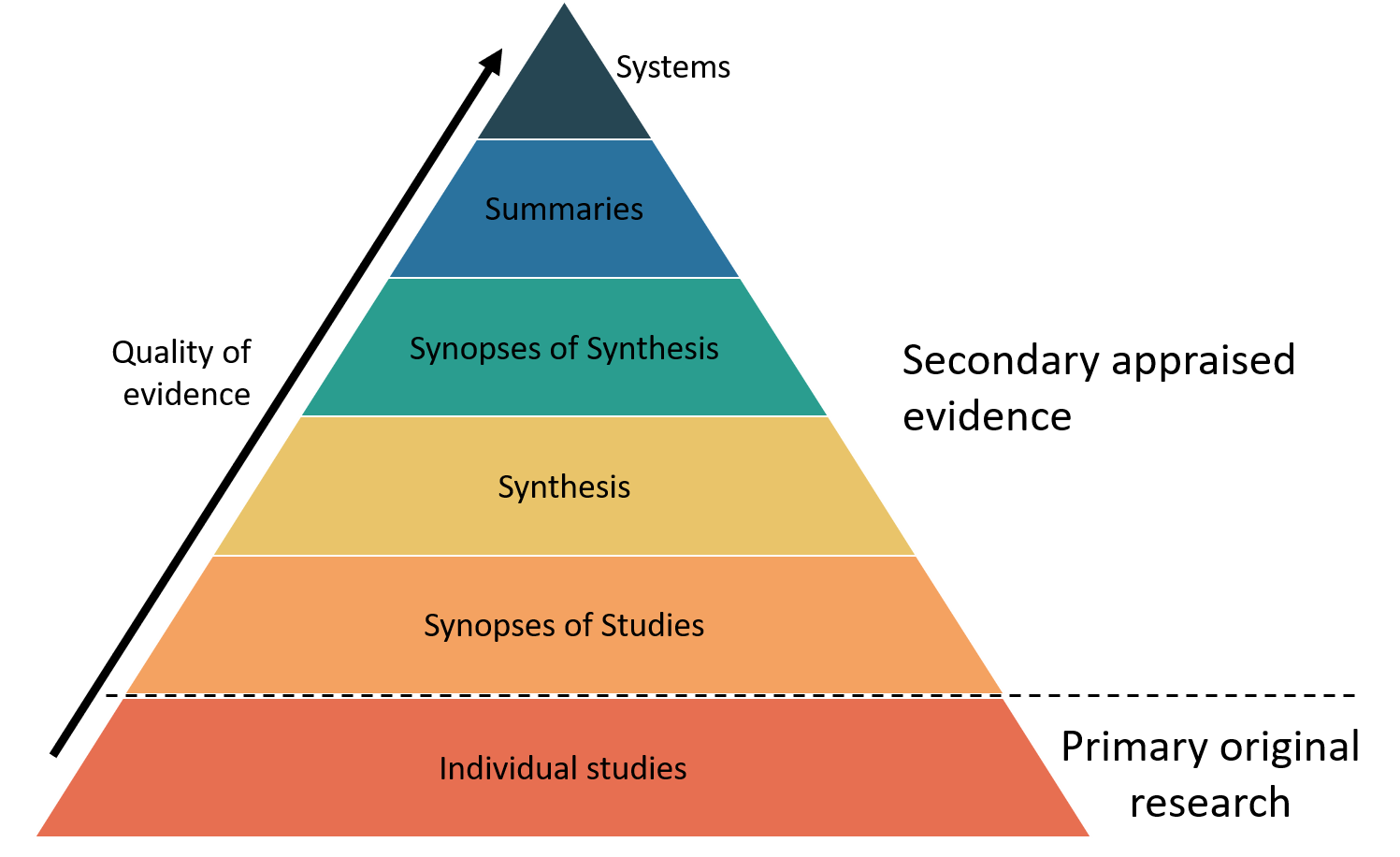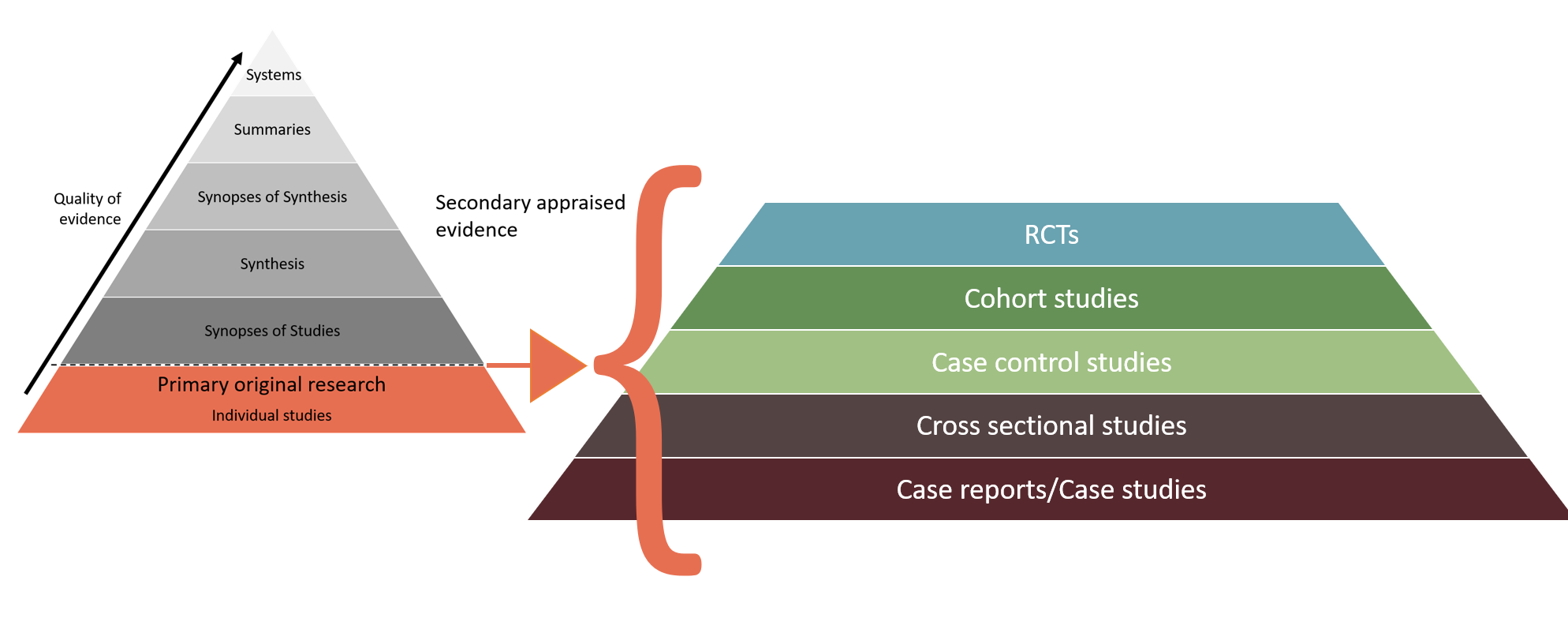Ask the clinical question - types of evidence and PICO
Create a clinical question using PICO
In formulating an answerable question, a good technique to use is to take your clinical problem and apply the PICO method:
P - Population or Patient group
I - Intervention or Indicator
C - Comparator or Control
O - Outcome
P: Population / Patient
- Who or What? Patient, Population, Problem.
- How would you describe a group of patients similar to your group?
- What are the most important characteristics of the patient? Primary problem; disease; co-existing conditions.
- Consider sex, age and/or race of a patient as this may be relevant to the diagnosis or treatment of a disease.
I: Intervention / Indicator
- Intervention, prognostic factor or exposure - Drug, procedure, diagnostic test, exposure.
- Which main intervention, prognostic factor, exposure are you considering?
- What do you want to do for the patient? Prescribe a drug? Order a test? Order surgery?
- What factor might influence the prognosis of the patient? Age; co-existing problems.
- What exposure has the patient experienced? Asbestos; cigarette smoke.
C: Comparator / Control
- What is the main alternative? Comparison or intervention?
- What is the main alternative to compare with the intervention?
- Are you trying to decide between? Two drugs; a drug and no medication or placebo; two diagnostic tests.
- Your clinical question may not always need a specific comparison.
O: Outcome
- What are you trying to accomplish, measure, improve, effect, achieve?
- What can you hope to accomplish measure, improve or affect?
- What are you trying to do for the patient? Relieve or eliminate the symptoms; reduce the number of adverse events; improve function or test scores.
Example
Clinical problem: A patient asks if drinking carrot juice will reduce the likelihood of developing prostate cancer.
Answerable clinical question:
P - In males
I - Does drinking carrot juice
C - Compared to not drinking carrot juice
O - Reduce the incidence of prostate cancer
Levels of evidence and types of questions
Levels of evidence

Answering clinical questions requires high quality evidence, so levels of evidence (or hierarchies of evidence) and research study designs are used in EBP to help identify the best possible evidence easily.
The 6 S levels of evidence (shown in these diagrams) show that secondary sources that have appraised and synthesised many individual studies are considered higher quality sources, compared to individual research studies (DiCesno, Bayley & Haynes, 2009; ehealth NSW, 2018). The highest level of evidence available should be what you use to answer clinical questions.
When individual studies are used, the research design of the studies is important to understand. Using higher quality research designs helps reduce bias, and increase the reliability of research, which helps support clinical decision making. However, many research questions can't be answered with study designs like a Randomised Control Trial (RCT), so the type of question you are asking must be taken into account.

Diagrams adapted from eHealth NSW (2018).
For more information about the levels of evidence, check the Introduction to Evidence-Based Practice and CIAP module from NSW Health.
Types of questions
Different types of clinical questions will require different levels of primary evidence to find appropriate, reliable answers. Understanding the type of clinical question you are asking and the appropriate research methodologies to answer it will also help you decide where to search for evidence, an how to appraise the evidence.
| Type of question | Explanation | Types of evidence to answer the question |
|---|---|---|
| Therapy (treatment) | Questions about the effectiveness of interventions in improving outcomes for patients. Includes medications, surgeries, or service delivery | Randomised Controlled Trial (RCT) |
| Prevention | Questions about reducing the chance of disease, identifying risk factors or screening | RCT or Prospective study |
| Diagnosis | Questions about the validity of diagnostic or screening tests | RCT or Cohort Study or Cross-sectional study |
| Prognosis | Questions about the likely course of a condition | Cohort Study or Case-Control Series or Longitudinal study |
| Etiology (causation) | Questions about determining if a harmful factor is related to the development or course of a condition | Cohort Study |
| Meaning | Questions about the patient experience | Qualitative Study |
References
DiCesno, A., Bayley, L., & Haynes, B. (2009). Accessing pre-appraised evidence: fine-tuning the 5S model into a 6S model. Evidence Based Nursing, 12(4). https://doi.org/10.1136/ebn.12.4.99-b
eHealth NSW. (2018). Clinical Information Access Portal (CIAP) EBP Learning Modules. https://www.ciap.health.nsw.gov.au/training/ebp-learning-modules/module1/index.html
